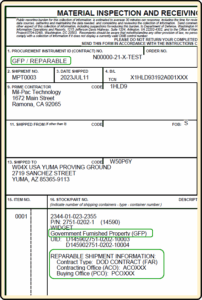What is the WAWF Reparable Receiving Report (RRR) and why do you need to use it for GFP? Its use is a DFARS requirement for Government-Furnished Property (GFP) shipments. The reasoning behind this makes the rule understandable.
- UID items shipped on a standard Receiving Report (RR) are added to the IUID Registry as new acquisition, established their cost and initial date of service.
- The Reparable Receiving Report simply transfers custody of existing items from the contractor to the Government.
What is a Reparable Receiving Report? On paper, it is simply a standard DD250 (RR) with some additional GFP-related data. This causes WAWF to update the custody of the item in the IUID Registry rather than add a new UID record for the item as though it was newly acquired.
The figure on the right highlights the additional GFP data that turns a DD250 into a Reparable Receiving Report. See the entire RRR DD250 illustrated.
GFP Module
Of course, shipping GFP is not quite as simple as adding some extra data. Because the process transfers custody of a shipped item from contractor to the Government, WAWF will confirm that the IUID Registry shows the item(s) in contractor custody. Contractors will need to add UID records to the Registry when appropriate.
The GFP Module was added to PIEE as the manager of GFP item custody. Prior to that the process had been handled through direct transactions with the IUID Registry. In January 2025, the DOD began strict enforcement of DFARS 252.245-7005 requiring use of the GFP Module for the management of contractor custody requests. Part of its purpose is to ensure that contractors are authorized to have specific GFP items.
Under GFP Module the Government would ideally create a Transfer Statement notifying contractors of GFP items that are due in. This would be the electronic equivalent of a DD1348 or DD1149. Until that is a reality, the contractor’s process looks like:
- Create a Transfer Statement in the PIEE GFP Module (or submit an EDI equivalent)
- If required, mark GFP items that require a Permanent Part Mark (IUID)
- Add any UID-marked items to the IUID Registry which are currently not registered
- Make shipments returning GFP items to Government custody using the Reparable Receiving Report.
Printed Forms: DD250 and WA250
The full adoption of WAWF as the instrument of acceptance by the Government resulted in it replacing the venerable printed DD250 in DFARS Appendix F. However, many still use the DD250 as a traveler included in shipments and when transmitting copies of the shipment in PDF form. Mil-Pac provides the WA250 as a reasonable alternative for WAWF shipments updated for modern DOD data requirements.
WAWF Property Transfer (DD1149) Transaction
The Property Transfer transaction, which is the WAWF equivalent of the DD1149, is used when transfer of custody of Government property occurs without cost. It could be used for:
- Replacement of GFP under warranty
- Return of items associated with servicing a GFP item, such as a vehicle in which a serviced item is embedded
- Return of an item into which a new acquisition item was installed
- Shipment of new acquisition items from Bonded Storage which were Shipped-In-Place (SIP)
Note that in the case of SIP, the shipment into Bonded Storage may take place on the standard RR if the items are new acquisition.
Acknowledging Custody of GFP in the IUID Registry
Successful completion of an RRR or DD1149, which transfers custody of items to the Government (or another contract), requires that one first acknowledge (gain) custody through the UID Registry. This may be done on the Government’s PIEE web site, or via electronic data interchange using one of two different formats.
Adding GFP Items to the IUID Registry
It is possible that UID items, even those with UID Part Markings, may not be in the IUID Registry. In which case, the unregistered item(s) can be added to the Registry at the time custody is acknowledged. Doing first-time registration of GFP items can be easily done with UID Registry EDI transactions. However, if the item was sold to the government after FY2015 new registration may occur only as part of a maintenance contract under which the registering company takes temporary custody of the item.


